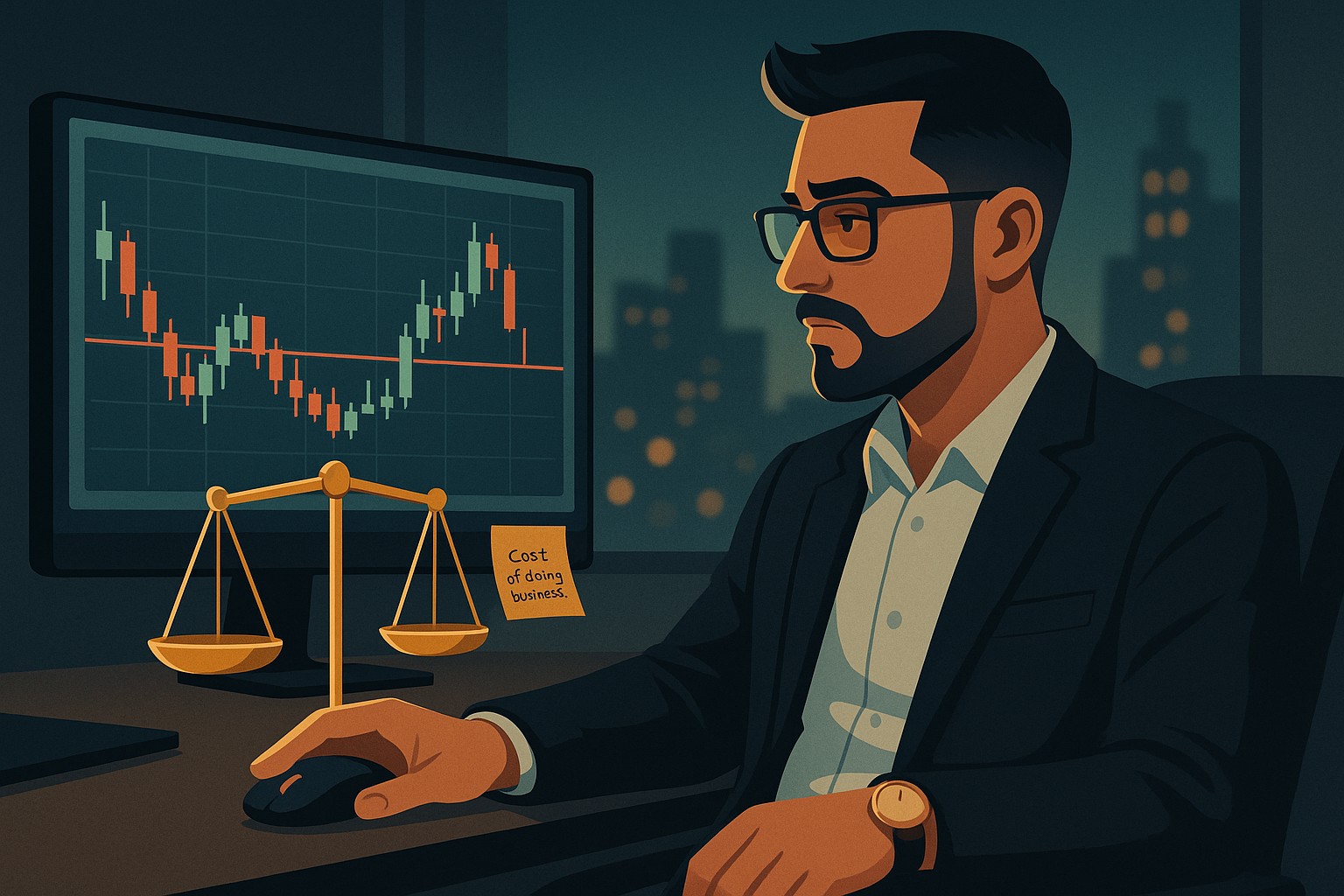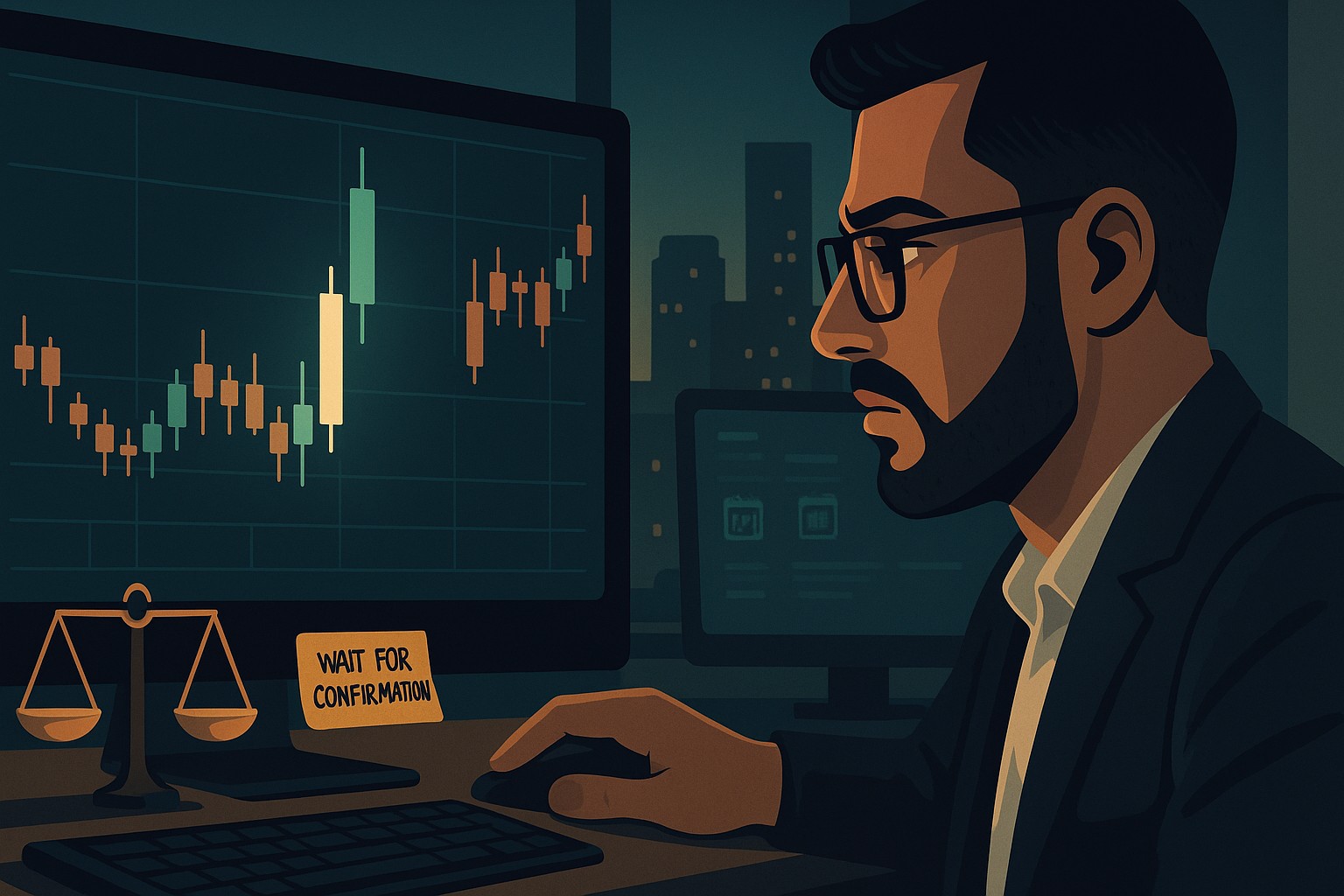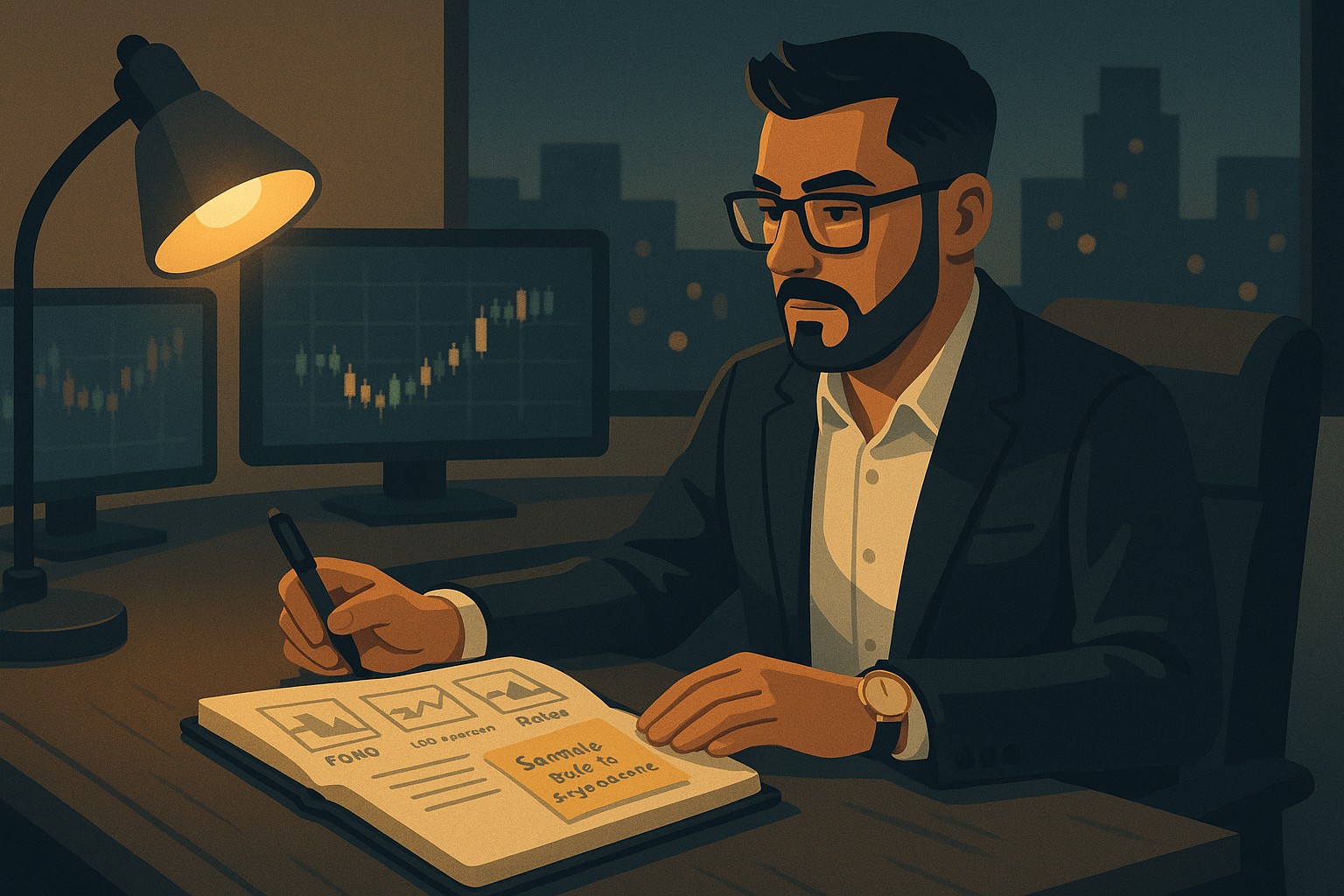The Psychology of Risk in Trading: Fear of Loss vs Fear of Missing Out
2025-11-05 09:43:06
In Trading in the Zone, Mark Douglas reveals a simple but powerful truth: traders do not lose because of poor analysis, they lose because of how they think about risk. Every chart, entry, or stop-loss exposes a battle between two emotions: fear of loss and fear of missing out (FOMO).
One keeps us too cautious, the other too aggressive, and both distort the one thing Douglas says we must protect: our ability to think in probabilities.

If you want a quick primer on this mindset, read Trading in the Zone: Thinking in Probabilities and pair it with Detachment Discipline in Trading to learn how to stay objective under pressure.
Core Narrative: The Dual Fear That Defines Risk

1. The Fear of Loss - The Pain of Uncertainty
Mark Douglas calls it the “mental discomfort of risk.” The brain interprets uncertainty as danger - and since trading is 100% uncertainty, every decision feels like a threat.
That’s why traders often:
- Move stops further to “give it room”
- Close trades too early after a few pips of profit
- Freeze up after a losing streak
The real problem isn’t the loss itself - it’s our relationship with losing.
Douglas writes that “a losing trade is simply the cost of doing business.”
If you can accept that emotionally, losses stop being personal and start being mechanical.
In his words:
“If you believe that trading is simply a probability game, there’s no reason to fear being wrong.”
For a practical system to size risk and protect capital while you retrain this response, review Mastering Risk Management: Stop Loss, Take Profit, and Position Sizing and Risk of Ruin in Trading.
Fear of loss turns trading into a survival game. Acceptance of loss turns it into a performance game. If you need a confidence anchor after a drawdown, practice with the routines in Managing Trading Losses: Why You Can Be Wrong and Still Win Big.
2. The Fear of Missing Out - The Illusion of Control
Then comes the opposite fear - FOMO.
Douglas points out that traders who chase trades are not driven by strategy, but by the illusion of certainty. They want to feel in control by being in the market.
But as he warns:
“The market is neutral - it doesn’t know you exist.”
FOMO thrives on the false belief that the market owes you an opportunity.
You start thinking, “If I don’t catch this one, I’ll miss the move.”
But that’s not a fact - it’s a distortion created by impatience and scarcity thinking.
When you truly internalize the probabilistic mindset, FOMO loses its power. You realize missing one trade means nothing when there’s an infinite stream of setups ahead.
Educational Analysis: The Douglas Framework of Emotional Risk

Douglas built his philosophy around five fundamental truths about the market. Two of them anchor this discussion perfectly:
- Anything can happen.
- You don’t need to know what will happen next to make money.
Those two statements destroy both fears if deeply understood.
- If anything can happen, you can’t fear one loss - because it’s expected.
- If you don’t need to know what’s next, you can’t fear missing out - because you can always wait for your edge.
The purpose of trading is not to be right; it’s to execute a system that gives you a statistical advantage over time.
That’s the mental reframe Douglas calls “thinking in probabilities.”
Once you adopt it, risk no longer feels dangerous. It becomes a cost - like paying rent to stay in the game.
Real-Life Analogy: The Trader on the Balance Beam

Picture The Trader standing on a balance beam.
To the left is fear of loss - paralysis, hesitation, self-doubt.
To the right is FOMO - rushing, chasing, overconfidence.
He can’t remove the beam or the drop below it - both are part of the game.
But like an acrobat, he learns to trust his form - his trading plan - and his rhythm - his consistency.
Each step becomes less emotional, more mechanical.
That’s the essence of being in the zone.
Applied Narrative: The Trader’s Internal Dialogue
The scene opens in the golden glow of his trading room.
The Trader sits before his monitors, eyes fixed on a setup forming perfectly - his model aligning across timeframes. Yet, a voice whispers: “What if it fails?” Another interrupts: “What if it runs without me?”
He breathes.
He remembers Douglas’ words:
“The best traders have no fear because they have learned to think differently - they have learned to believe in the uniqueness of every moment.”
So he executes - not because he’s certain, but because he’s prepared.
That’s emotional balance in risk-taking.
Finding Equilibrium: Emotional Neutrality through Structure
Here’s how you can build Douglas’ equilibrium between fear and freedom:
1. Accept Randomness as Structure
Paradoxically, structure comes from embracing randomness. You don’t control the outcome; you control the process.
- Risk a fixed amount every trade.
- Let probabilities, not emotions, dictate when to act.
- Expect both wins and losses before they even happen.
2. Journal the Emotion, Not Just the Trade
Every time you hesitate or rush, write it down.
Note the trigger - fear of loss or FOMO? Over time, you’ll recognize emotional patterns stronger than price patterns.
3. Rely on Your Sample Size
As Douglas said, consistency is the result of a series of trades, not any single outcome.
Missing one move doesn’t affect your edge. Violating your process does.
If you are still building that edge, follow the path in Proving Your Edge: Backtesting Without Bias and Forward Testing in Trading.
4. Detach Identity from Outcome
You are not your trades.
Losses don’t make you a bad trader; they make you a trader operating in a probabilistic environment.
That’s the mental shift from amateur to professional.
Challenge for This Week
This week, practice what Douglas calls “emotional neutrality.”
Before each trade, ask yourself:
“Am I entering to avoid fear - or to express my edge?”
Document every decision driven by fear of loss or FOMO.
At the end of the week, reflect: How many were process-aligned versus emotionally-reactive?
You’ll notice - the less you need to control the outcome, the more control you gain over yourself.
Final Thoughts

In Trading in the Zone, Douglas teaches that true consistency comes when your mind accepts uncertainty as certainty.
When you no longer need the market to validate you.
When both fear of loss and fear of missing out fade into neutrality - replaced by calm execution of your edge.
That’s the real psychology of risk.
And that’s how you enter the Zone.
FAQs
1. How does “Trading in the Zone” define emotional mastery?
Douglas defines mastery as the ability to remain completely neutral to outcomes - trading from confidence in your edge, not attachment to results.
If you need a mental reset, start with The Inner War: Fear, Greed, and the Illusion of Control.
2. Can fear ever be useful in trading?
Only as feedback. Fear reveals what you haven’t fully accepted - like losses, randomness, or uncertainty. Once accepted, fear loses its grip.
3. What’s the quickest way to stop FOMO?
Shift from event-based thinking (“I must catch this move”) to statistical thinking (“I’ll catch many moves across 100 trades”). That’s Douglas’ core teaching.
Use Flow State Trading to structure your sessions and The Ultimate Guide to Understanding Market Trends and Price Action to wait for your context to align.
4. Why do traders keep repeating emotional mistakes?
Because they never transform belief systems. Douglas said, “You don’t trade the market; you trade your beliefs about the market.” Until beliefs change, behavior repeats.
Rewire those beliefs with Trading Hack: Why You Keep Breaking Your Own Rules and reinforce with Discipline vs. Impulse in Trading.
Start Practicing with Confidence - Risk-Free!
- Trade forex, indices, gold, and more
- Access ACY, MT4, MT5, & Copy Trading Platforms
- Practice with zero risk
It’s time to go from theory to execution - risk-free.
Create an Account. Start Your Free Demo!
Check Out My Contents:
Strategies That You Can Use
Looking for step-by-step approaches you can plug straight into the charts? Start here:
- How To Trade & Scalp Indices at the Open Using Smart Money Concepts (SMC)
- How to Trade Breakouts Effectively in Day Trading with Smart Money Concepts
- Complete Step-by-Step Guide to Day Trading Gold (XAU/USD) with Smart Money Concepts (SMC)
- The Power of Multi-Timeframe Analysis in Smart Money Concepts (SMC)
- Forex Trading Strategy for Beginners
- Mastering Candlestick Pattern Analysis with the SMC Strategy for Day Trading
- How to Use Fibonacci to Set Targets & Stops (Complete Guide)
- RSI Divergence Trading Strategy for Gold: How to Identify and Trade Trend Reversals
- Stochastics Trading Secrets: How to Time Entries in Trending Markets using Stochastics
- Gold Trading Stochastics Strategy: How to Trade Gold with 2R - 3R Targets
- RSI Hidden Divergence Explained: How to Spot Trend Continuations Like a Pro
- Moving Averages Trading Strategy Playbook
- Mastering Fibonacci Trading Psychology - Trusting the Levels, Managing the Mind
- Mastering Price Action at Key Levels - How to Spot, Trade, and Win at the Most Crucial Zones
- Mastering Retests: How to Enter with Confirmation After a Breakout
Indicators / Tools for Trading
Sharpen your edge with proven tools and frameworks:
- The Ultimate Guide to Risk Management in Trading - A Complete Compilation for 2025
- Moving Averages Trading Strategy Playbook
- How to Think Like a Price Action Trader
- Mastering Fibonacci Trading Psychology - Trusting the Levels, Managing the Mind
How To Trade News
News moves markets fast. Learn how to keep pace with SMC-based playbooks:
- Why Smart Money Concepts Work in News-Driven Markets - CPI, NFP, and More
- How to Trade NFP Using Smart Money Concepts (SMC) - A Proven Strategy for Forex Traders
- How to Trade CPI Like Smart Money - A Step-by-Step Guide Using SMC
- Learn to Trade News by Backtesting it with Forex Tester
Learn How to Trade US Indices
From NASDAQ opens to DAX trends, here’s how to approach indices like a pro:
- How to Start Trading Indices and Get into the Stock Market with Low Capital (2025 Guide)
- Best Indices to Trade for Day Traders | NASDAQ, S&P 500, DAX + Best Times to Trade Them
- How To Trade & Scalp Indices at the Open Using Smart Money Concepts (SMC)
- NAS100 - How to Trade the Nasdaq Like a Pro (Smart Money Edition)
How to Start Trading Gold
Gold remains one of the most traded assets - here’s how to approach it with confidence:
- How to Swing Trade Gold (XAU/USD) Using Smart Money Concepts: A Simple Guide for Traders
- Complete Step-by-Step Guide to Day Trading Gold (XAU/USD) with Smart Money Concepts (SMC)
- The Ultimate Guide to Backtesting and Trading Gold (XAU/USD) Using Smart Money Concepts (SMC)
- Why Gold Remains the Ultimate Security in a Shifting World
- How to Exit & Take Profits in Trading Gold Like a Pro: Using RSI, Range Breakdowns, and MAs as Your Confluence
- Backtest Gold using Forex Tester Online
How to Trade Japanese Candlesticks
Candlesticks are the building blocks of price action. Master the most powerful ones:
- Mastering the Top Japanese Candlesticks: The Top 5 Candlesticks To Trade + Top SMC Candlestick Pattern
- How to Trade Candlestick Patterns with High Probability: A Complete Guide for Beginners
- The Top Japanese Candlestick Guide: What is an Engulfing Pattern and How to Trade It?
- Piercing Pattern Candlestick Explained: How to Trade It - Step-By-Step Guide
- Morning & Evening Star Candlestick Patterns - How to Trade Market Reversals with Confidence
How to Start Day Trading
Ready to go intraday? Here’s how to build consistency step by step:
- 5 Steps to Start Day Trading: A Strategic Guide for Beginners
- 8 Steps How to Start Forex Day Trading in 2025: A Beginner’s Step-by-Step Guide
- 3 Steps to Build a Trading Routine for Consistency and Discipline - Day Trading Edition
- The Ultimate Guide to Understanding Market Trends and Price Action
- Trading with Momentum: The Best Trading Session to Trade Forex, Gold and Indices
Swing Trading 101
- Introduction to Swing Trading
- The Market Basics for Swing Trading
- Core Principles of Swing Trading
- The Technical Foundations Every Swing Trader Must Master
- Swing Trader’s Toolkit: Multi-Timeframe & Institutional Confluence
- The Psychology of Risk Management in Swing Trading
- Swing Trading Concepts To Know In Trading with Smart Money Concepts
- Becoming a Consistent Swing Trader: Trading Structure & Scaling Strategy
Learn how to navigate yourself in times of turmoil
Markets swing between calm and chaos. Learn to read risk-on vs risk-off like a pro:
- How to Identify Risk-On and Risk-Off Market Sentiment: A Complete Trader’s Guide
- How to Trade Risk-On and Risk-Off Sentiment - With Technical Confirmation
- The Ultimate Guide to Understanding Market Trends and Price Action
- Metals in Risk-On and Risk-Off Environments: How Sentiment Moves Gold and Commodities
Want to learn how to trade like the Smart Money?
Step inside the playbook of institutional traders with SMC concepts explained:
- Why Smart Money Concepts Work: The Truth Behind Liquidity and Price Action
- Mastering the Market with Smart Money Concepts: 5 Strategic Approaches
- Understanding Liquidity Sweep: How Smart Money Trades Liquidity Zones in Forex, Gold, US Indices
- The SMC Playbook Series Part 1: What Moves the Markets? Key Drivers Behind Forex, Gold & Stock Indices
- The SMC Playbook Series Part 2: How to Spot Liquidity Pools in Trading - Internal vs External Liquidity Explained
- Fair Value Gaps Explained: How Smart Money Leaves Footprints in the Market
- Accumulation, Manipulation, Distribution: The Hidden Cycle That Runs Every Market
- Institutional Order Flow - Reading the Market Through the Eyes of the Big Players
- London Session Trading Secrets: How Smart Money Sets the High & Low of the Day
- Mastering the New York Session - Smart Money Concepts Guide
- Anatomy of a Perfect Execution: How SMC Traders Trade with Precision
- Step-by-Step Trading Confirmation Guide for Precise Execution
- Execution Psychology: Turning Hesitation into Confidence
Master the World’s Most Popular Forex Pairs
Forex pairs aren’t created equal - some are stable, some are volatile, others tied to commodities or sessions.
- The Top 5 All-Time Best Forex Pairs to Trade
- Top Forex Pairs Beyond the Big Five
- EUR/USD: The King of Forex
- USD/JPY: The Fast Mover
- GBP/USD: The Volatile Cable
- AUD/USD: The Commodity Currency
- USD/CAD: The Oil-Backed Pair
- GBP/JPY: How to Trade The Beast
- Asian & London Session Secrets
- Mastering the New York Session
Metals Trading
- Metals Trading: Why Gold and Metals Are Rising Again
- Silver Trading: The Underdog with Dual Identity
- Gold vs Silver: Institutional Demand Breakdown Explained
- How to Day Trade Silver Like a Pro: Smart Money Tactics for XAG/USD
- Platinum & Palladium: The Quiet Power Duo of Industrial Metals
- How to Trade Metals with SMC and Fundamentals - Gold Trading Strategy
- Metals in Risk-On and Risk-Off Environments: How Sentiment Moves Gold and Commodities
- Future of Metals Market: Gold Forecast 2026 & Long-Term Commodities Outlook
Stop Hunting 101
If you’ve ever been stopped out right before the market reverses - this is why:
- Stop Hunting 101: How Swing Highs and Lows Become Liquidity Traps
- Outsmarting Stop Hunts: The Psychology Behind the Trap
- How to Lessen Risk From Stop Hunts in Trading
- How Stop Hunts Trigger Revenge Trading - Breaking the Pain Cycle
- How to Accept Stop Hunts Without Losing Discipline - Shifting From Frustration to Focus
Trading Psychology
Mindset is the deciding factor between growth and blowups. Explore these essentials:
- The Mental Game of Execution - Debunking the Common Trading Psychology
- Managing Trading Losses: Why You Can Be Wrong and Still Win Big in Trading
- The Hidden Threat in Trading: How Performance Anxiety Sabotages Your Edge
- Why 90% of Retail Traders Fail Even with Profitable Trading Strategies
- Top 10 Habits Profitable Traders Follow Daily to Stay Consistent
- Top 10 Trading Rules of the Most Successful Traders
- Top 10 Ways to Prevent Emotional Trading and Stay Disciplined in the Markets
- Why Most Traders Fail - Trading Psychology & The Hidden Mental Game
- Emotional Awareness in Trading - Naming Your Triggers
- Discipline vs. Impulse in Trading - Step-by Step Guide How to Build Control
- Trading Journal & Reflection - The Trader’s Mirror
- Overcoming FOMO & Revenge Trading in Forex - Why Patience Pays
- Risk of Ruin in Trading - Respect the Math of Survival
- Identity-Based Trading: Become Your Trading System for Consistency
- Trading Psychology: Aligning Emotions with Your System
- Mastering Fear in Trading: Turn Doubt into a Protective Signal
- Mastering Greed in Trading: Turn Ambition into Controlled Growth
- Mastering Boredom in Trading: From Restless Clicking to Patient Precision
- Mastering Doubt in Trading: Building Confidence Through Backtesting and Pattern Recognition
- Mastering Impatience in Trading: Turn Patience Into Profit
- Mastering Frustration in Trading: Turning Losses Into Lessons
- Mastering Hope in Trading: Replacing Denial With Discipline
- When to Quit on Trading - Read This!
- The Math of Compounding in Trading
- Why Daily Wins Matter More Than Big Wins
- Scaling in Trading: When & How to Increase Lot Sizes
- Why Patience in Trading Fuels the Compounding Growth
- Step-by-Step Guide on How to Manage Losses for Compounding Growth
- The Daily Habits of Profitable Traders: Building Your Compounding Routine
- Trading Edge: Definition, Misconceptions & Casino Analogy
- Finding Your Edge: From Chaos to Clarity
- Proving Your Edge: Backtesting Without Bias
- Forward Testing in Trading: How to Prove Your Edge Live
- Measuring Your Edge: Metrics That Matter
- Refining Your Edge: Iteration Without Overfitting
- The EDGE Framework: Knowing When and How to Evolve as a Trader
- Scaling Your Edge: From Small Account to Consistency
- Trading in the Zone: Execution Through Habit and Structure
- Trading in the Zone: Thinking in Probabilities
- The Inner War: Fear, Greed, and the Illusion of Control
- Detachment Discipline in Trading: How to Let Go of the Need to Be Right
- Trading Hack: Why You Keep Breaking Your Own Rules (And How to Stop)
- Trading Mindset Mastery: Building Confidence Through Data
- Flow State Trading: Entering the Zone Through Structure
- Cognitive Traps in Trading: Overconfidence, Recency Bias & Revenge Trades
Market Drivers
- Central Banks and Interest Rates: How They Move Your Trades
- Inflation & Economic Data: CPI Trading Strategy and PPI Indicator Guide
- Geopolitical Risks & Safe Havens in Trading (Gold, USD, JPY, CHF)
- Jobs, Growth & Recession Fears: NFP, GDP & Unemployment in Trading
- Commodities & Global Trade: Oil, Gold, and Forex Explained
- Market Correlations & Intermarket Analysis for Traders
Risk Management
The real edge in trading isn’t strategy - it’s how you protect your capital:
- Mastering Risk Management: Stop Loss, Take Profit, and Position Sizing
- Why Risk Management Is the Only Edge That Lasts
- How Much Should You Risk per Trade? (1%, 2%, or Less?)
- The Ultimate Risk Management Plan for Prop Firm Traders - Updated 2025
- Mastering Position Sizing: Automate or Calculate Your Risk Like a Pro
- Martingale Strategy in Trading: Compounding Power or Double-Edged Sword?
- How to Add to Winners Using Cost Averaging and Martingale Principle with Price Confirmation
- Managing Imperfect Entries in Trading - How Professionals Stay Composed
Suggested Learning Path
If you’re not sure where to start, follow this roadmap:
- Start with Trading Psychology → Build the mindset first.
- Move into Risk Management → Learn how to protect capital.
- Explore Strategies & Tools → Candlesticks, Fibonacci, MAs, Indicators.
- Apply to Assets → Gold, Indices, Forex sessions.
- Advance to Smart Money Concepts (SMC) → Learn how institutions trade.
- Specialize → Stop Hunts, News Trading, Turmoil Navigation.
This way, you’ll grow from foundation → application → mastery, instead of jumping around randomly.
Follow me for more daily market insights!
Jasper Osita - LinkedIn - FXStreet - YouTube
This content may have been written by a third party. ACY makes no representation or warranty and assumes no liability as to the accuracy or completeness of the information provided, nor any loss arising from any investment based on a recommendation, forecast or other information supplies by any third-party. This content is information only, and does not constitute financial, investment or other advice on which you can rely.
Try These Next
4 Powerful Tactics to Overcome the Most Costly Forex Mistakes
How to Master MT4 & MT5 - Tips and Tricks for Traders
The Importance of Fundamental Analysis in Forex Trading
Forex Leverage Explained: Mastering Forex Leverage in Trading & Controlling Margin
The Importance of Liquidity in Forex: A Beginner's Guide
Close All Metatrader Script: Maximise Your Trading Efficiency and Reduce Stress
Best Currency Pairs To Trade in 2025
Forex Trading Hours: Finding the Best Times to Trade FX
MetaTrader Expert Advisor - The Benefits of Algorithmic Trading and Forex EAs
Top 5 Candlestick Trading Formations Every Trader Must Know















